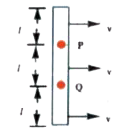ree identical rods moving with velocity v are smoothly hinged at the points P and Q. If the middle rod is suddenly stopped, after what time the other two rods will collide?

Topper's Solved these Questions
- ROTATIONAL MECHANICSBook:AAKASH SERIESChapter:ROTATIONAL MECHANICSExercise:Questions for Descriptive Answers
Explore 20 Videos
- ROTATIONAL MECHANICSBook:AAKASH SERIESChapter:ROTATIONAL MECHANICSExercise:Numerical Exercise (LEVEL-1)
Explore 18 Videos
- ROTATIONAL DYNAMICS Book:AAKASH SERIESChapter:ROTATIONAL DYNAMICS Exercise:PRACTICE SHEET (ADVANCED) Integer Type Questions
Explore 7 Videos
- SIMPLE HARMONIC MOTION Book:AAKASH SERIESChapter:SIMPLE HARMONIC MOTION Exercise:ADDITIONAL PRACTICE EXERCISE (LEVEL - II)(PRACTICE SHEET (ADVANCED)) (INTEGER TYPE QUESTIONS)
Explore 3 Videos
Similar Questions
A uniform rod PQ of mass m and length t rotates with an angular velocity a while its center moves with linear velocity v=2ω⋅f3 on a smooth horizontal surface If the end Q of the rod is suddenly gets stuck at the moment as shown in the figure then angular velocity of the rod will be
View SolutionTwo points of a rod move with velocity 3v and v perpendicular to the rod and in the same direction. Separated by a distance r. Then the angular velocity of the rod is :
View Solution
Knowledge Check
Two points of a rod move with velocity 3v and v perpendicular to the rod and in the same direction, separated by a distance r. Then the angular velocity of the rod is :
A3vrB4vrC5vrD2vrTwo long parallel metallic wires with a resistance 'R' from a horizontal plane . A conducting rod AB is on the wires shown in figure . The space has magnetic field pointing vertically downwards. The rod is given an initial velocity 'v0'. There is no friction in the wire and the rod . After a time 't' the velocity v of the rod will be such that :-
 Av>v0Bv>v0Cv=v0Dv=−v0
Av>v0Bv>v0Cv=v0Dv=−v0A uniform rod of length l and mass 2m rests on a smooth horizontal table. A point of mass m moving horizontally at right angle to the rod with velocity v collides with one end of the rod and sticks to it, then:
Aangular velocity of the system after collision is vlBangular velocity of the system after collision is v2lCthe loss in kinetic enerlgy of the system as a whole as a result of the collision is mv26Dthe loss in kinetic energy of the system as a whole as a result of the collision is 7mv224
A rod of mass m and length l hinged at the centre is placed on a horizontal surface. A bullet of mass m moving with velocity v strikes the end A of the rod and gets embedded in it. The angular velocity with which the systems rotates about its centre of mass after the bullet strikes the rod

View SolutionTwo identical rods are joined at their middle points The ends are maintained at constant temperatures as indicated Find the temperature of the junction
 .
.
View SolutionA rod of mass m and length l hinged at the centre is placed on a horizontal surface. A bullet of mass m moving with velocity v strikes the end. A of the rod and gets embedded in it. The angular velocity with which the systems rotates about its centre of mass after the bullet strikes the rod

View SolutionA uniform rod AB of length l and mass m hangs from point A in a car moving with velocity v0 on an inclined plane as shown in Fig. The rod can rotate in vertical plane about the axis at point A. if the car suddenly stops, the angular speed with which the rod starts rotating is

View SolutionA uniform rod AB of length l and mass m hangs from point A in a car moving with velocity v0 on an inclined plane as shown in Fig. The rod can rotate in vertical plane about the axis at point A. if the car suddenly stops, the angular speed with which the rod starts rotating is

View Solution
